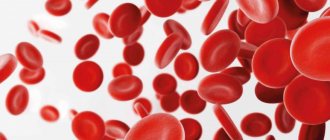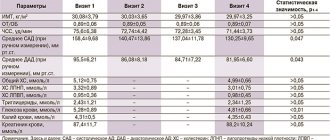Aug 28, 2007
Currently, the role of arterial hypertension (AH) in the development of atherosclerosis and systemic damage to peripheral arteries of target organs (heart, brain and kidneys) is generally recognized. The higher the blood pressure (BP), the greater the risk of developing cerebral stroke, coronary heart disease and sudden death. There is a positive correlation between the blood pressure value and the overall mortality rate: with an increase in systolic blood pressure by 10 mm Hg. Art. the risk of developing cardiovascular accidents increases by 10%. Calcium antagonists (ACa++) are first-line drugs in the treatment of hypertension, and the main place in this pharmacological group belongs to dihydropyridine derivatives. Although the use of short-acting ACa++ is still the subject of scientific debate, given the high bioavailability, the use of drugs in this group is justified. This statement is supported by the results of a clinical study of the use of ACa++ short-acting dihydropyridine series PHARMADIPINE, conducted under the leadership of Anastasia Galitskaya, senior researcher at the Institute of Cardiology. N. D. Strazhesko AMS of Ukraine.
Anastasia Galitskaya, Candidate of Medical Sciences, senior researcher at the Department of Clinical Rheumatology, Research Institute of Cardiology named after. N. D. Strazhesko AMS of Ukraine
— The drug PHARMADIPINE was developed at our institute by Professor A.P. Viktorov, produced by Farmak OJSC and is a 2% solution of nifedipine for oral use.
The issue of a therapeutic niche for the use of nifedipine solution was discussed at the level of the institute's management; a clinical trial protocol was developed, according to which patients were prescribed PHARMADIPINE in a low dose - 5-7 drops. Blood pressure levels were recorded at the 5th minute after taking the drug, then every 10 minutes for the 1st hour and every half hour for the 2nd and 3rd hours.
Typically, clinical trials are limited to small numbers of participants—about 30 patients per clinical unit. In this case, to achieve the most objective assessment, test protocols were distributed to almost all clinical departments of the institute - chronic ischemic heart disease, myocardial diseases and heart defects, symptomatic hypertension, essential hypertension, myocardial infarction and rehabilitation treatment, as well as to the arrhythmia department. The study also included patients from the institute’s clinic, where a team of cardiologists sees patients daily.
If a patient undergoing inpatient treatment or an outpatient developed a hypertensive crisis, he was prescribed PHARMADIPINE and blood pressure was recorded according to the above scheme (in the hospital the patient was under the supervision of the attending physician, in the clinic he was observed for 3-4 hours).
The effectiveness of PHARMADIPINE in relieving a hypertensive crisis has been proven in large-scale clinical studies, in which 226 patients were examined according to the protocol.
Let's compare: for a dissertation work it is necessary to analyze 80-100 clinical cases, thus the reliability of the results of this study is very high. At the end of the test, all protocols were collected, the data were brought together and their statistical analysis was carried out with the compilation of correlation graphs and tables.
Then, to conduct a study according to the extended protocol, a group of 45 patients who received basic complex antihypertensive therapy was formed. In the case of a hypertensive crisis, 24-hour Holter monitoring of blood pressure and ECG was carried out, a general blood and urine test, ECG and echoCG studies were performed before and after (after 3 days) taking PHARMADIPINE. After statistical processing of the data, the time of onset and duration of the hypotensive effect of the drug reliably coincided with the results of the previous trial and it was proven that taking PHARMADIPINE does not affect biochemical and general clinical parameters.
A statistically significant antihypertensive effect develops in the 8-10th minute after taking PHARMADIPINE, the maximum - in the 30-40th minute and lasts for 3-4 hours.
The drug cannot be prescribed routinely. We proceeded and continue to believe that short-acting ACa++ should be used once and only when indicated (like nitroglycerin during an angina attack). Having stopped the crisis, planned therapy should be immediately prescribed using angiotensin-converting enzyme inhibitors, long-acting ACa++, thiazide diuretics, b-adrenergic receptor blockers, etc.
If the rapid but short-term hypotensive effect of PHARMADIPINE is not “fixed in time,” a lasting effect will not be achieved, the crisis may develop again and the patient’s condition will worsen. It should be remembered that sudden changes in blood pressure levels - especially in older patients and with concomitant pathology - significantly increase the risk of developing cardiovascular accidents.
Based on the results of the study, changes were made to the instructions for use of PHARMADIPINE: in the original annotation the initial dose of use was indicated - 20 drops, but when using this regimen, collapse may occur (especially often in elderly and senile people); It has now been established that the optimal dose of the drug is 5-7 drops, and for elderly patients 3-5 drops are sufficient.
Short-acting ACa++ PHARMADIPINE can be used not only in cardiology hospitals, but also in clinics and in a selected individual dose at home.
Clinical recommendations for the use of PHARMADIPINE emphasize that this drug must be provided to the emergency medical service. PHARMADIPINE has a number of advantages that make it unsurpassed for urgent relief of high blood pressure: rapid antihypertensive effect (5-10 minutes), simplicity and accuracy of dosing (1 drop of solution contains 1 mg of nifedipine), ease of use (a few drops orally in a small amount of water or, even better, sublingually on a piece of sugar), economic availability (1 bottle of 25 ml - about 3.5 UAH).
And the main competitive advantage of PHARMADIPINE is that there is no other liquid dosage form of nifedipine (neither domestic nor foreign production) for urgent relief of hypertensive crisis on the Ukrainian pharmaceutical market.
Clinical recommendations prepared on the basis of the indicated advantages of the drug were included in the curriculum of cardiology schools, held quarterly by the institute in one of the regional centers of Ukraine. During their implementation, cardiologists were recommended to use in clinical practice an effective antihypertensive (and promising in terms of studying the antianginal effect) fast-acting ACa++ - the domestic drug PHARMADIPIN.
Photo by Evgeniy Krivsha
Share Tweet
Back to Farmak in the media Previous Next
Pharmacological properties of the drug Farmadipin
Nifedipine (2,6-dimethyl-4-(2-nitrophenyl)-1,4-dihydropyridine-3,5-dicarboxylate) has antianginal and hypotensive effects. Blocks the entry of calcium ions into cardiomyocytes and smooth muscle cells of coronary and peripheral arteries through slow voltage-dependent calcium channels of cell membranes. Relaxes vascular smooth muscles, eliminates spasms, dilates coronary and peripheral arteries, reducing blood pressure, peripheral vascular resistance, afterload on the heart and myocardial oxygen demand; slightly reduces myocardial contractility and heart function. Slightly reduces platelet aggregation. When taken orally, it is well absorbed from the digestive tract, bioavailability is 40–60%. The effect develops especially quickly (within 5–10 minutes) when taken sublingually. Typically, the maximum effect develops after 30–40 minutes. Food intake does not have a significant effect on the rate of absorption of the drug. The hemodynamic effect lasts for 4–6 hours. Up to 90% of nifedipine binds to plasma proteins. Metabolized in the liver and excreted from the body mainly in the form of inactive metabolites. The total clearance of nifedipine is 0.4–0.6 l/kg/h. The half-life is 2-4 hours. In elderly people and patients with liver cirrhosis, the metabolism of nifedipine slows down, so in them the half-life of the drug can be extended by almost 2 times, which requires a dose reduction and an increase in the intervals between doses of the drug. Nifedipine does not accumulate in the body. In small quantities it penetrates the blood-brain barrier and the placental barrier and is excreted in breast milk.
Farmadipin 2% 25 ml drops for oral administration
Instructions for medical use of the drug FARMADIPINE Trade name Farmadipine International nonproprietary name Nifedipine Dosage form Drops for oral use 2% Composition 1 ml of solution contains the active substance - nifedipine in terms of 100% substance - 20 mg, excipients: macrogol 400 - 0.8 ml, ethanol (96%) up to 1 ml Description Transparent yellow or greenish-yellow viscous liquid with a faint alcohol odor Pharmacotherapeutic group Selective blockers of “slow” calcium channels. Dihydropyridine derivatives. ATC code C08C A05 Pharmacological properties Pharmacokinetics When taken orally, it is well absorbed in the digestive tract, bioavailability is 40-60%. The effect develops especially quickly (within 5-10 minutes) when taken sublingually. Typically, the maximum effect is recorded after 30-40 minutes. Food intake does not significantly affect the rate of absorption of the drug. The hemodynamic effect lasts for 4-6 hours. Up to 90% of nifedipine is bound to plasma proteins. Metabolized in the liver and excreted from the body mainly in the form of inactive metabolites. The total clearance of nifedipine is from 0.4 to 0.6 l/kg/h. The half-life is 2-4 hours. In elderly people and patients with liver cirrhosis, the metabolism of nifedipine slows down, so their half-life of the drug can be extended by almost 2 times, which requires a dose reduction and an increase in the intervals between doses of the drug. Nifedipine does not accumulate in the body. In small quantities it penetrates the blood-brain and placental barriers and is excreted in breast milk. Pharmacodynamics Farmadipine exhibits antianginal and antihypertensive effects. Blocks the entry of calcium ions into cardiomyocytes and smooth muscle cells of coronary and peripheral arteries through slow voltage-dependent calcium channels of cell membranes. Relaxes vascular smooth muscles, eliminates spasms and dilates coronary and peripheral arteries, reducing peripheral vascular resistance, blood pressure, afterload and myocardial oxygen demand; slightly reduces myocardial contractility, slightly reduces platelet aggregation. Indications for use - arterial hypertension (for the treatment of hypertensive crises) Method of administration and dosage In case of a sudden increase in blood pressure (BP 180/100 mm Hg - 190/110 mm Hg), the initial single dose for adults is 3-5 drops (2 mg – 3.35 mg), for elderly and senile people – no more than 3 drops (2 mg) under the tongue or drop onto a piece of cracker or sugar, holding it in the mouth for as long as possible. If effectiveness is insufficient, the dose can be gradually increased to a clinically significant effect. In the future, in cases of increased blood pressure, it is necessary to focus on this dose. If necessary (increase in blood pressure to 190/100 mm Hg - 220/110 mm Hg), the single dose can be gradually increased in some cases to 10-15 drops (6.7 mg -10 mg), taking into account individual changes the patient's blood pressure indicators. The maximum single dose is 10 mg (15 drops). The maximum daily dose is 15-30 mg (21 drops-45 drops). Side effects - nausea - tachycardia - arterial hypotension - chest pain - "flushes" of blood to the face and upper body - swelling of the legs - weakness, dizziness, headache, drowsiness Rarely - allergic reactions in the form of skin rashes - parasthesia - depression - tremor fingers - increased daily diuresis - blurred vision - gum hyperplasia (with long-term use) Contraindications - allergic reaction to the components of the drug - cardiogenic shock, acute myocardial infarction, unstable angina, tachycardia - severe aortic and mitral stenosis - arterial hypotension - severe heart failure - weakness of the sinus node - porphyria - pregnancy and lactation - children under 18 years of age Drug interactions The hypotensive effect of Farmadipin is enhanced by drugs from the group of β-blockers, nitrates, diuretics, other antihypertensive drugs, tricyclic antidepressants, alcohol-containing drugs and drinks. In some cases, nifedipine causes a decrease in the concentration of quinidine in the blood plasma, and its withdrawal causes a significant increase in it. Based on this, when carrying out combination therapy, it is recommended to monitor the concentration of quinidine in the blood plasma. Diltiazem reduces the clearance of Farmadipine. Fentanyl significantly enhances the hypotensive effect, so taking Farmadipin should be stopped at least 36 hours before fentanyl is administered. When beta-blockers are used together with Farmadipin, the development of arterial hypotension and heart failure (especially with propranolol) is possible. Farmadipine increases the concentration of digoxin, carbamazepine and theophylline in the blood. Cimetidine increases the concentration of Farmadipine in the blood plasma. Rifampicin weakens the therapeutic effect of Farmadipin by accelerating its metabolism. Special instructions It is necessary to take into account the individual sensitivity of individual patients to Farmadipin. In such cases, the dose is selected individually, starting with three drops and gradually increasing by 2-3 drops (1.34 mg - 2 mg) until a clinical effect is achieved. Exceeding the initial dose of the drug can lead to a sharp decrease in blood pressure! Features of the effect of the drug on the ability to drive a vehicle or potentially dangerous mechanisms The drug can affect the psychophysical state of patients, which is manifested by weakening of attention, slower reactions, and requires caution when driving vehicles and working with potentially dangerous mechanisms. Overdose Symptoms: sharp decrease in blood pressure, heart failure, shock, metabolic acidosis and convulsions. Treatment: gastric lavage, intake of activated carbon, administration of sympathomimetics, calcium chloride, symptomatic therapy. Release form and packaging Drops for oral use 2%. 5 ml or 25 ml in glass bottles, enclosed with instructions for medical use in a cardboard box. Storage conditions Store in a dry place, protected from light and out of reach of children, at a temperature of 15 ºС to 25 ºС. Keep out of the reach of children! Shelf life: 3 years The drug should not be used after the expiration date indicated on the package. Conditions for dispensing from pharmacies By prescription Manufacturer OJSC “Farmak” Address: Ukraine, 04080, Kiev, st. Frunze, 63.
Use of the drug Farmadipin
Farmadipine is prescribed sublingually. In case of a sudden increase in blood pressure (180/100–190/110 mm Hg), the initial single dose of the drug in adults is 3–5 drops (2–3.35 mg), in elderly and senile people - no more than 3 drops ( 2 mg) under the tongue (you can drop Farmadipin onto a piece of sugar or cracker and ask the patient to hold it in the mouth for as long as possible). If effectiveness is insufficient, the dose of the drug is gradually increased to clinically effective. In the future, when blood pressure increases, it is necessary to focus on this dose. If necessary (increase in blood pressure to 190/100–220/110 mm Hg), the single dose of the drug can be gradually increased to 10–15 drops (6.7–10 mg), taking into account changes in blood pressure in a particular patient. It is necessary to take into account the increased sensitivity of individual patients to Farmadipine. In these cases, the dose is selected individually, starting with 3 drops and gradually increasing it by 2-3 drops (1.34-2 mg) until the required clinical effect is achieved. Exceeding the initial dose of the drug can lead to a sharp decrease in blood pressure!
Contraindications
Framadipine drops should not be used:
- if allergic to the active substance or auxiliary components;
- pregnant (up to 20 weeks) and lactating women;
- for aortic stenosis , myocardial infarction , unstable angina ;
- patients with ileostomy or colostomy ;
- with cardiogenic shock ;
- in combination with rifampicin .
Drug interactions Farmadipin
The hypotensive effect of Farmadipin is enhanced by drugs from the group of β-adrenergic receptor blockers, nitrates, diuretics, other antihypertensive drugs, tricyclic antidepressants, drugs and drinks containing alcohol. In some cases, nifedipine reduces the concentration of quinidine in the blood plasma, and its withdrawal significantly increases it. Based on this, when carrying out combination therapy, it is recommended to monitor the concentration of quinidine in the blood plasma. Diltiazem reduces the clearance of Farmadipine. Fentanyl significantly enhances the hypotensive effect, so taking Farmadipin should be stopped at least 36 hours before fentanyl is administered. When beta-blockers are used together with Farmadipin, hypotension may develop. Farmadipine increases the concentration of digoxin, carbamazepine and theophylline in the blood. Cimetidine increases the concentration of Farmadipine in the blood plasma. Rifampicin weakens the therapeutic effect of Farmadipin by accelerating its metabolism.
Side effects
Possible adverse reactions from taking Farmadipin:
- anxiety, insomnia ;
- hyperglycemia;
- agranulocytosis , leukopenia ;
- nosebleeds, dyspnea , nasal congestion;
- tachycardia , angina pectoris ;
- edema , angioedema , urticaria , rashes, anaphylactic reactions ;
- polyuria , dysuria ;
- headache , vertigo , tremor , migraine , drowsiness , hypersthesia , paresthesia , dysesthesia ;
- impaired visual acuity, painful sensations in the eyes;
- convulsions , joint swelling, myalgia , arthralgia ;
- decreased blood pressure , loss of consciousness, vasodilation ;
- constipation , pain in the epigastric region, nausea, flatulence , dry mucous membranes, dysphagia ;
- jaundice , increased activity enzymes ;
- intestinal obstruction, intestinal ulcer , vomiting, gingival hyperplasia , bezoar ;
- fever;
- toxic epidermal necrolysis , purpura , light sensitivity, erythema ;
- decreased libido , erectile dysfunction .
Price for Farmadipin drops
The price of Farmadipin is approximately 20 hryvnia per 25 ml bottle.
- Online pharmacies in RussiaRussia
- Online pharmacies in UkraineUkraine
- Online pharmacies in KazakhstanKazakhstan
LuxPharma* special offer
- Farmadipin drops 2% fl.
25ml 1480 rub. order
show more
Pharmacy24
- Farmadipin 2% 25 ml solution PAT "Farmak", Ukraine
43 UAH. order - Farmadipin 2% 5 ml solution PAT "Farmak", Ukraine
31 UAH order
PaniPharmacy
- Farmadipin liquid Farmadipin solution 2% 5ml Ukraine, Farmak OJSC
38 UAH order
- Farmadipin liquid Farmadipin solution 2% 25ml Ukraine, Farmak OJSC
50 UAH order
show more
Analogs
Level 4 ATC code matches:
Lacipil
Cordafen
Azomex
Nimodipine
Felodipin
Nifedipine
Amlotop
Nimotop
Tenox
Nifecard HL
Cordipin
Felodip
Normodipine
Phenigidine
Norvask
Cordaflex
Lerkamen
Corinfar
Vero-Amlodipine
Amlodipine
Cordaflex, Lerkamen, Vero-Amlodipine, Amlodipine, Adalat, Cordipine, Corinfar, Nifedipine, Phenigidine, Emlodin, Amlotop, Nimotol, Tenox, Felodip, Tensigal, Tenox, Normodipine, Nemotan, Nifecard XL, Cordipine, Norvasc.
Reviews of Farmadipin drops
Reviews about the medicine are good. Drops quickly and effectively reduce high blood pressure, especially during a hypertensive crisis . Some people don’t really like the specific smell and taste of the product, and the fact that it is difficult to wash off after it gets on clothes.
You need to be careful when taking the medicine. You can use the drug only after consulting a doctor.
Reviews about Farmadipin:
“Farmadipine was prescribed to my father. He is a lifelong hypertensive patient, and after suffering from an illness his blood pressure sometimes jumps sharply. The other day, my dad’s blood pressure rose to 200. Thanks to the drops, he quickly came to his senses and his blood pressure returned to normal”;
“I experienced an attack of hypertensive crisis several times because I have been suffering from hypertension for a long time. In order to somehow prevent a crisis or alleviate it in the event of an attack, the cardiologist recommended purchasing 2% Farmadipin oral drops. This is a cheap and effective drug available at any pharmacy. Now I always keep it with me.”
During pregnancy and lactation
Nifedinip should not be prescribed to women in the first trimester of pregnancy .
Animal studies have shown that the drug has low embryotoxicity and fetotoxicity . However, the question of taking the drug by pregnant women should be decided after consultation with the attending physician.
breastfeeding while the drug is working .
Overdose
In case of an overdose of the drug, the following occurs: decreased blood pressure , tachycardia , bradycardia , hypoxia , metabolic acidosis , impaired consciousness, even coma , pulmonary edema .
To eliminate the unwanted symptoms of an overdose, it is necessary to remove the drug from the body as soon as possible and stabilize the patient’s condition, primarily blood pressure and other hemodynamic parameters.
After oral administration, it is recommended to perform gastric lavage and, if necessary, rinse the small intestine.
Hemodialysis is ineffective; plasmapheresis . beta-sympathomimetics , calcium preparations (10-20 ml of calcium chloride or calcium gluconate intravenously), dopamine , norepinephrine is also indicated , and if life is threatened, installation of an artificial pacemaker . Caution should be exercised when introducing any liquid into the body, as this increases the load on the heart muscle.
special instructions
It should be remembered that the medicine should not be given to patients with an ileostomy .
After taking the medicine, you cannot take x-rays of the gastrointestinal tract using barium contrast agent . These studies may be false positive.
For patients with severely low blood pressure (below 90 mmHg) or for heart failure, the drug is recommended to be used with extreme caution.
If the patient has severe narrowing in the gastrointestinal tract , this can lead to the development of obstructive symptoms. Bezoars , which require surgery, are very rare to form.
In case of severe liver diseases, it is necessary to adjust the dosage of the drug and closely monitor the functioning of the liver.
Experiments conducted in vitro showed that the drug affects sperm and quality.
ischemic heart pain or angina pectoris developed during the previous dose .
With extreme caution, the drug is prescribed to patients who are on hemodialysis , in the presence of hypovolemia or low blood pressure .
Patients with diabetes insulin dosage adjustment .
At the initial stages of treatment with the drug, it is recommended to refrain from driving.






